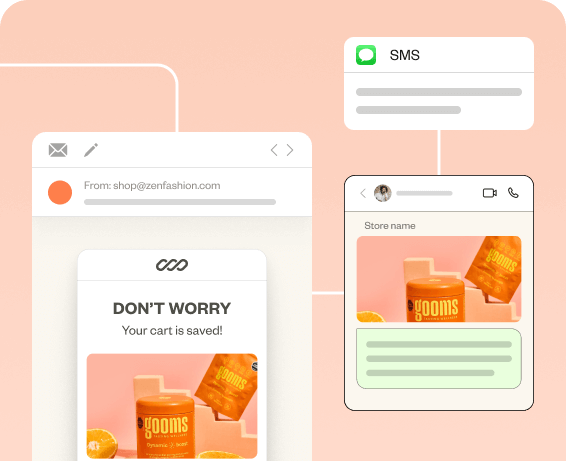Most re-engagement emails end up ignored, unopened, or straight in the trash. But customers ghost you for real reasons, maybe your messaging was dull, your offers generic, or your timing totally off.
To reconnect with inactive customers, your re-engagement email campaign must acknowledge real objections, deliver personalized value, and genuinely feel human.
When done right, great customer re-engagement email marketing strategies turn inactive customers into active buyers again. The difference is understanding your audience why they went quiet and directly addressing their hesitations and frustrations.
In this blog, I’ll break down best re-engagement email examples and proven strategies to get inactive customers to open, click, and buy again.
What is a Re-engagement Email?
A re-engagement email is a message sent to inactive subscribers to revive interest, prompt action, and prevent churn.
It often includes special offers, updates and new improvements to reignite the relationship and encourage the customer to purchase again.
When to Send Re-engagement Email Marketing Campaigns?
Sent at the right time, best re-engagement emails can turn inactive customers into repeat buyers.
Here are the times to send re-engagement emails:
- After a Period of Inactivity (30, 60, or 90 Days)
- Abandoned Cart (Within 1-24 Hours)
- Browse Abandonment (1-3 Days Later)
- Expiring Offer (24-48 Hours Before Deadline)
- Post-Purchase but No Repeat Purchase (30-60 Days Later)
In email marketing, sending personalized emails based on where customers are in the email marketing funnel and engagement history is the sure-shot way to increase conversions. Re-engagement emails are a type of email campaign that is sent based on engagement and purchase history.
Related Reading: Explore best win-back email examples to reconnect with inactive customers: 9 Best Win-Back Email Examples that Retain Customers
8 Best Customer Re-engagement Email Examples
The best re-engagement emails excel in design and copywriting – successfully reactivating inactive/old customers.
The best customer re-engagement email examples are:
- Re-engagement after browse abandonment
- Reminding the customer about the product they saw
- Re-engaging inactive customers with a simple reminder
- ‘We Miss You’ email for re-engaging inactive customers
- B2B re-engagement email for pitching about new improvements
- Product recommendations based on products viewed
- Reminder for abandoned cart
- Reminder about expiring exclusive offer
Let’s pick apart these templates in detail.
1. Re-engaging customer after browse abandonment
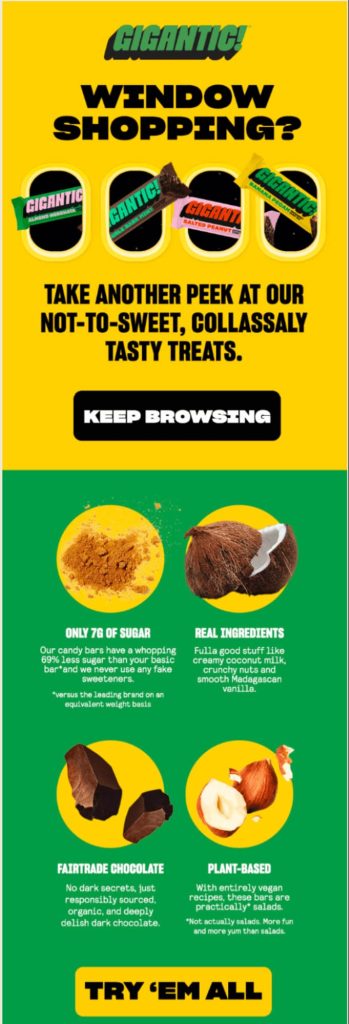
Why is this the best re-engagement email example?
This re-engagement email template nails the essentials of re-engaging customers with a bold, fun, and highly effective design.
The re-engagement email example addresses potential health-conscious concerns in a way that’s clear and direct. This will resonate well with today’s values-driven consumers.
This example followed the important re-engagement email best practice – keeping the copy short and sweet, making it easy to digest. The template highlights the key product benefits in a way that’s quick to read and visually appealing.
2. Reminding the customer about the product they saw
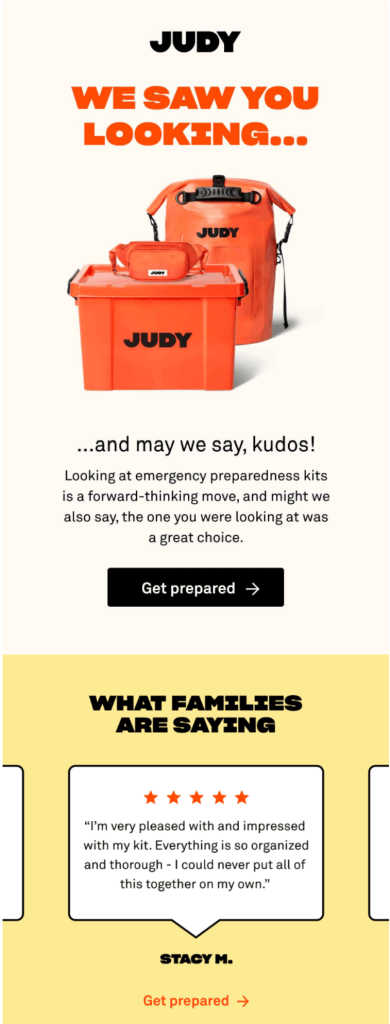
Why is this the funny customer re-engagement email marketing example?
The tagline is not your typical, bland one – it speaks directly to the recipient’s behavior and creates a sense of personal connection.
This template used an important re-engagement email marketing strategy – the use of humor (“…and may we say, kudos!”) makes the email feel friendly and inviting, breaking through the typical “salesy” tone.
Also, this funny re-engagement email example gets straight to the point: the customer is being reminded of a product they were interested in, and here’s why it’s a great choice.
In this re-engagement email template design important elements like the headline, product images, and customer reviews are visually separated, so the reader can quickly digest the content. The use of bold fonts and contrasting colors ensures that the email is easy to scan.
3. Re-engaging inactive customers with a simple reminder
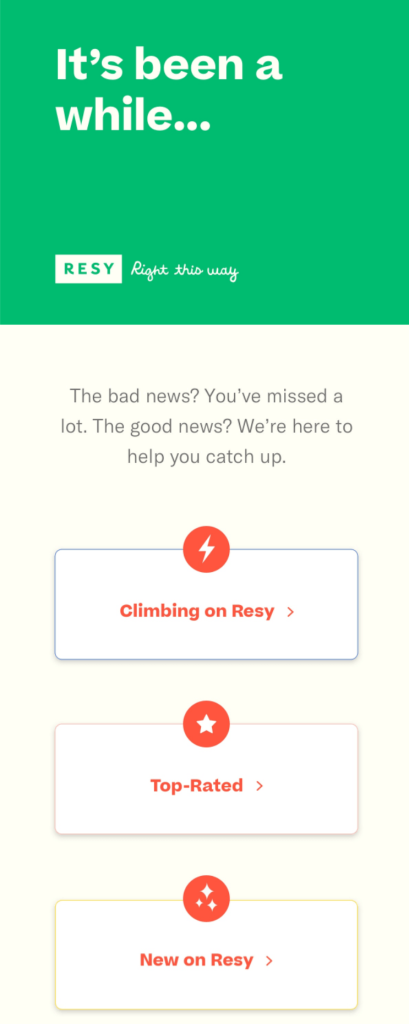
Why is this the best re-engagement email?
This re-engagement email template design is minimalistic and easy to digest. There’s no clutter – just a clear message and easy-to-click buttons.
The CTAs “Climbing on Resy, Top-Rated, and New on Resy” – used bold colors and icons to stand out. These CTAs are action-oriented and make it clear what the recipient can do next, whether they’re looking to explore trending spots or new content.
4. ‘We Miss You’ email for re-engaging inactive customers
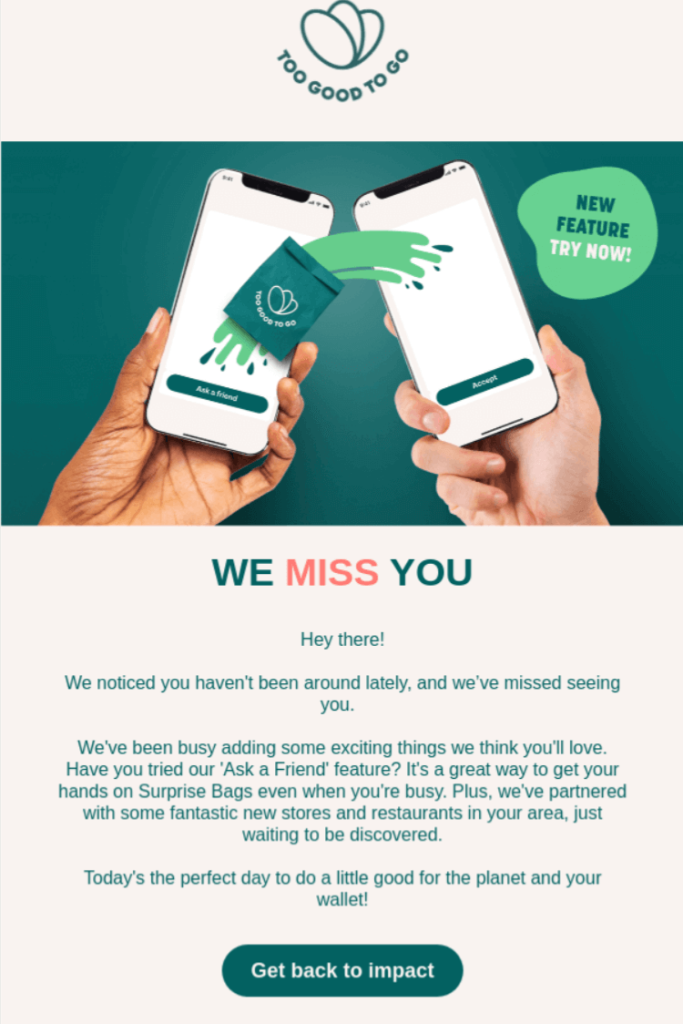
Why is this a good re-engagement email marketing template?
This re-engagement email example is casual and conversational. The opening, “Hey there!” is inviting and breaks the corporate formality. This email copywriting makes you feel like you’re receiving a message from a friend rather than a business trying to sell something.
Also, this example for re-engaging subscribers introduces a fresh feature: “Ask a Friend.” It’s a great way to generate interest by focusing on a new offering that adds value.
5. B2B re-engagement email for pitching about new improvements

Why is this the best B2B re-engagement email example?
The headline immediately highlights the key benefits: rewards and faster finances. It’s clear, concise, and directly speaks to the value proposition the recipient will get from reconnecting with Shopify Balance.
Also, this B2B re-engagement email example breaks down the key features into bullet points. Bullet points are scannable. It lets recipients see all the important details at a glance without feeling overwhelmed.
Related Reading: Explore more email marketing examples and get inspired to design innovative ones:
6. Product recommendations based on products viewed
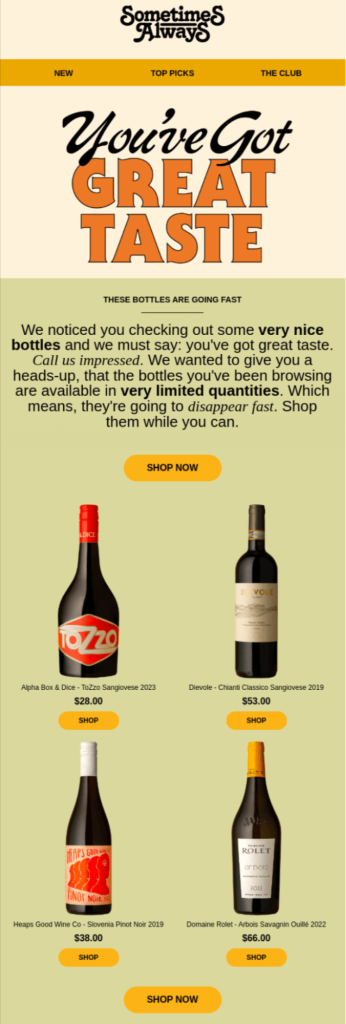
Why this is the best re-engagement email example?
Instead of generic “we miss you” messaging, this best re-engagement email speaks directly to the customer’s interest in specific products, which encourages further action.
Also, this example uses the best email marketing strategy – FOMO. “These bottles are going fast.” motivates customers to act quickly, as the products they are interested in are running out.
7. Reminder for abandoned cart

Why this is the best re-engagement email template?
Creating urgency is one of the most important best practices while writing re-engagement emails. By emphasizing that the products are limited in quantity, the re-engagement email template creates a sense of immediate need, encouraging the customer to complete their purchase before it’s too late.
Including clear, high-quality images and product names is the best re-engagement email marketing strategy that helps the customer easily recognize the items they abandoned.
Also, the CTA button, “FINISH CHECKING OUT,” is placed prominently in the email template. It’s bold, direct, and actionable – exactly what you need to drive conversions.
8. Reminder about an expiring exclusive offer

Why is this the best re-engagement email?
The “Save $40” CTA button is bold, clear, and directly connected to the offer. It’s not buried among unnecessary copy. The CTA is directing the customer’s attention to one action: finish their purchase.
The copy “It won’t be there for long” adds a sense of urgency to the offer, creating a fear of missing out (FOMO). This encourages customers to act now, not later.
Highlighting key features in the re-engagement email template helps customers understand why they should care about the product. This provides additional context for why they need the product, creating a stronger connection to the purchase decision.
Re-engagement Email Campaign Strategies and Best Practices
If you get these re-engagement email marketing strategies right, you’ll win back loyal customers who may have slipped through the cracks.
Here are the best practices for writing re-engagement emails:
- Address customer objections directly
- Segment the inactive users
- Highlight new features or content
- Send a series based on previous engagement
- Scarcity sells
- Acknowledge inactivity
- Use personalized product recommendations
Let’s dig into these re-engagement email best practices.
1. Address customer objections directly
If a customer has been inactive for a while, there’s likely an objection – whether it’s price, value, or usability. Address those concerns head-on in the email.
The best re-engagement email marketing strategy is to address all these concerns while writing re-engagement email copy.
Here is a great customer re-engagement email that does objection handling like a pro.
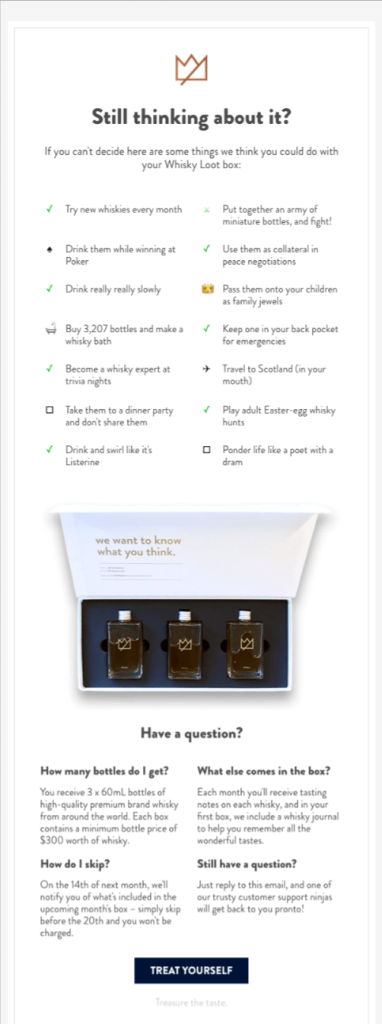
The above re-engagement email campaign example isn’t your typical “please come back” email.
Also, this re-engagement email example is a masterclass in customer objection handling. They know the reader is hesitating, so they included 10+ use cases of what the customer could do with their product. This will seal the deal for customers who are on the fence about value of the product.
2. Segment the Inactive Users
Don’t send the same re-engagement email campaign message to everyone.
The best re-engagement email marketing strategy is to segment inactive customers.
Here are some of the segmentation criteria you can consider for sending personalized re-engagement emails:
- Duration of inactivity: Time elapsed since the last engagement or interaction with the brand.
- Recency: How long it has been since the customer’s last purchase.
- Frequency: How often the customer made purchases in the past.
- Monetary value: The total amount spent historically.
- Email engagement: Historical patterns of email opens, clicks, and interactions.
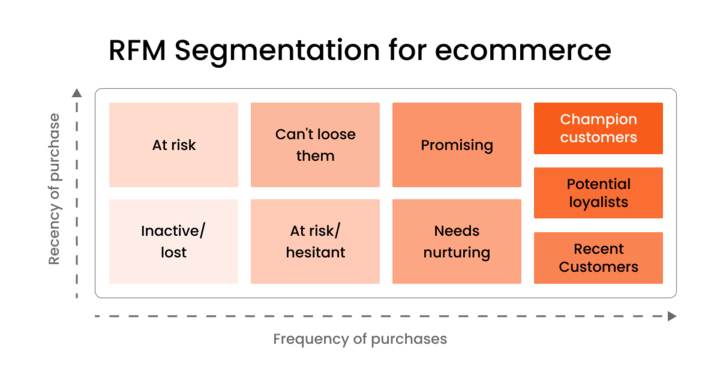
3. Highlight New Features or Content
Customers leave for many reasons. Maybe they’ve outgrown your product, or they think there’s nothing new.
So, the best re-engagement email marketing strategy to reconnect with old customers is to send them a fresh content alert about new features or upgrades. Show them what they’re missing.
4. Send re-engagement email series based on previous engagement
Don’t send the same re-engagement email message to everyone.
The best practice is to create a sequence of re-engagement emails based on how the customer engaged with your last email. If they clicked but didn’t convert, send a follow-up email with more compelling content.
Here is an example marketing automation workflow for writing re-engagement email to reconnect old/inactive customers.
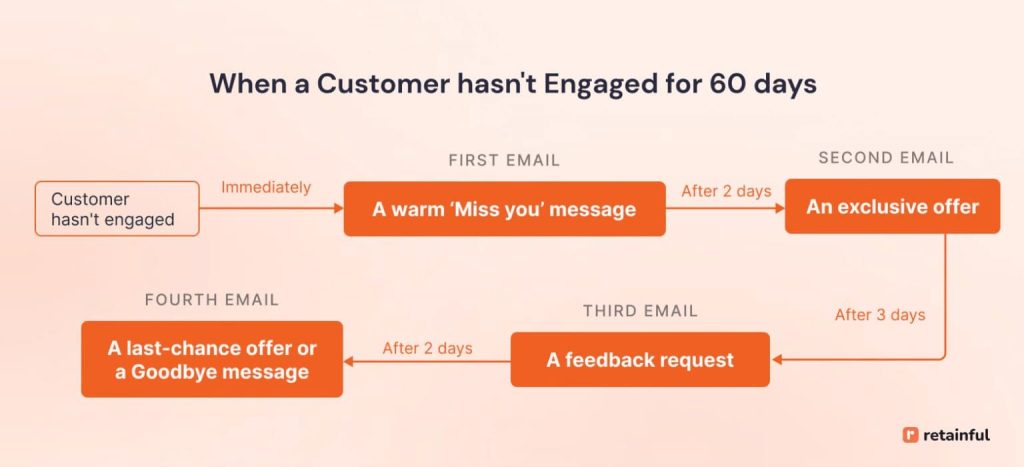
5. Scarcity sells
Make reactivation urgent while writing re-engagement email copy: “This deal expires in 24 hrs.” Deadlines move action better than any clever copy alone.
6. Acknowledge inactivity
While writing a re-engagement email, directly reference their silence: “It’s been 3 months – we miss you. Anything we can fix?” So, honest acknowledgment beats pretending nothing happened.
7. Use Personalized Recommendations
While writing customer re-engagement emails, include recommendations based on their past behavior. Whether it’s products they’ve browsed or categories they love, personalized suggestions make customers feel like you’re talking directly to them. Relevance equals conversion.
How to Create a Re-engagement Email Series?
A re-engagement email series is more likely to reactivate customers than a single email. With email automation, you can set up a re-engagement email sequence in clicks.
The steps to create re-engagement email are:
- Step 1: Choose an email marketing tool
- Step 2: Select the segmentation criteria
- Step 3: Set up re-engagement email sequence
- Step 4: Design responsive re-engagement email templates
- Step 5: Analyze results and optimize
Let’s see in detail.
Step 1: Choose an email marketing tool
The first step to run a re-engagement email campaign is to choose an email marketing software.
Here ate the criteria to consider
- Easy-to-setup email automation and pre-built workflows
- Visual automation builder
- Ready-made email templates
Explore more email marketing software to automate re-engagement email:
8 Best Email Automation Software Comparison
10 Best Email Marketing Apps For Shopify Analysed
Step 2: Select the segmentation criteria
Segment the inactive customers based on periods of inactivity and purchase history to send personalized re-engagement email.
For example here are the top 5 customer segments for re-engagement email campaigns based on purchase history and inactivity duration:
- Recent High-Value Inactives (30–60 days) – Frequent high spenders who’ve recently stopped purchasing.
- Recent Low-Value Inactives (30–60 days) – Lower-value customers who’ve recently become inactive.
- One-Time Purchasers (60+ days inactive) – Bought once and haven’t returned; targeted offers encourage second purchase.
- Former Loyal Customers (6+ months inactive) – Regular customers inactive for a long time; personalized win-back strategies required.
- Seasonal Buyers Inactive Beyond Usual Season – Customers who purchased during specific seasons but are now overdue.
Step 3: Setup re-engagement email sequence
Use email automation to create re-engagement email sequence at well-timed intervals.
Here are the ideal re-engagement email sequence to use for different workflows:
1. Re-engagement email sequence for re-connecting inactive customers
Email 1: We Miss You! email
Email 2: Improvement and new features/products
Email 3: Win-back offer
Email 4: Last chance to claim the offer
2. Re-engagement email sequence for reminding about expiring offer
Email 1: A simple reminder – ”Don’t Forget About Your [X%] Off!”
Email 2: Urgency about the limited time offer with clear expiration time
Email 3: Last chance to redeem the offer
3. Re-engagement email series after browse abandonment
Email 1: Reminder about product seen with images and thier key benefits
Email 2: Urgency about stock running out
Email 3: Last chance to get the product
4. Re-engagement email series after cart abandonment
Email 1: A gentle reminder + upselling (1 hour after cart abandonment)
Email 2: Evoking urgency ( 1 day after cart abandonment)
Email 3: Offer an incentive (2 days after cart abandonment)
Email 4: Urgency about the offer (5-7 days after cart abandonment)
Email 5: The last chance offer ( 10 days after cart abandonment)
Step 4: Design responsive re-engagement email templates
Designing a responsive re-engagement email template means creating an email that looks great and functions properly across all devices, from desktop to mobile.
Here are tips for designing responsive re-engagement email templates:
- Use a single-column layout. It adapts well to all screen sizes and keeps your message direct.
- Ensure there’s enough whitespace to prevent the email from feeling crowded or overwhelming.
- Use a large, contrasting CTA button with action-oriented text.
Step 5: Analyze results and optimize
While running re-engagement email campaigns, track key email marketing metrics closely:
- Open rates
- Click-through rates
- Reactivation percentage
- Unsubscribe rates
Optimize re-engagement email marketing campaigns for reactivating inactive customers based on data insights – continuously optimize your series.
Explore more email marketing templates and get great design inspirations:
11 Best Ecommerce Email Templates + Examples
15 Best Email Marketing Examples For 2025
9 Post-Purchase Email Examples That Retain Customers
Wrapping up!!
Use the re-engagement email examples we’ve covered as inspiration – don’t settle for generic. Write re-engagement emails that speak directly to customer needs, add compelling offers, and create a sense of urgency.
Whether it’s offering exclusive discounts, showcasing new products, or simply reminding customers of the benefits of your brand, a designed re-engagement email template can turn lost opportunities into lasting relationships.
Also Read:
- Retention Marketing: Strategies + Examples
- Customer Lifecycle Marketing – 16 Strategies for All Stages
- Call To Action Examples For Your E-commerce Store
Frequently Asked Questions
While writing re-engagement email address why the customer hasn’t engaged, remind them of their past behavior, and provide incentives like discounts or exclusive offers to entice them back.
A typical re-engagement campaign consists of 3-5 emails. Start with a reminder, follow up with incentives, provide value-based content, and end with a final “last chance” message to re-engage or gracefully part ways.
Re-engagement focuses on email outreach to inactive subscribers while retargeting uses ads to bring back users based on their previous website activity.
Re-engagement emails should target
1. Inactive subscribers (30 – 90 days of activity)
2. Customers who have abandoned the cart
3. Customers who viewed a product but didn’t buy
4. Customers who haven’t availed of an expiring offer
Send re-engagement emails 3-6 months after a customer becomes inactive. However, the timing depends on the customer’s behavior – target after a noticeable drop in engagement to catch them before they become completely disengaged.
Subject lines for B2B re-engagement are:
1. “We Miss You—Here’s What’s New”
2. “Don’t Miss Out on Our Latest Solutions for [Industry]”
3. “We’ve Got a New Offer to Help [Problem]”
To re-engage disengaged customers, send personalized content that addresses their needs, offer exclusive deals, remind them of past interactions, and use urgency to encourage immediate action.
To reactivate an inactive customer, send a personalized offer or reminder email highlighting new products, special discounts, or content based on their previous behavior. Make the re-engagement offer time-sensitive for a sense of urgency.
